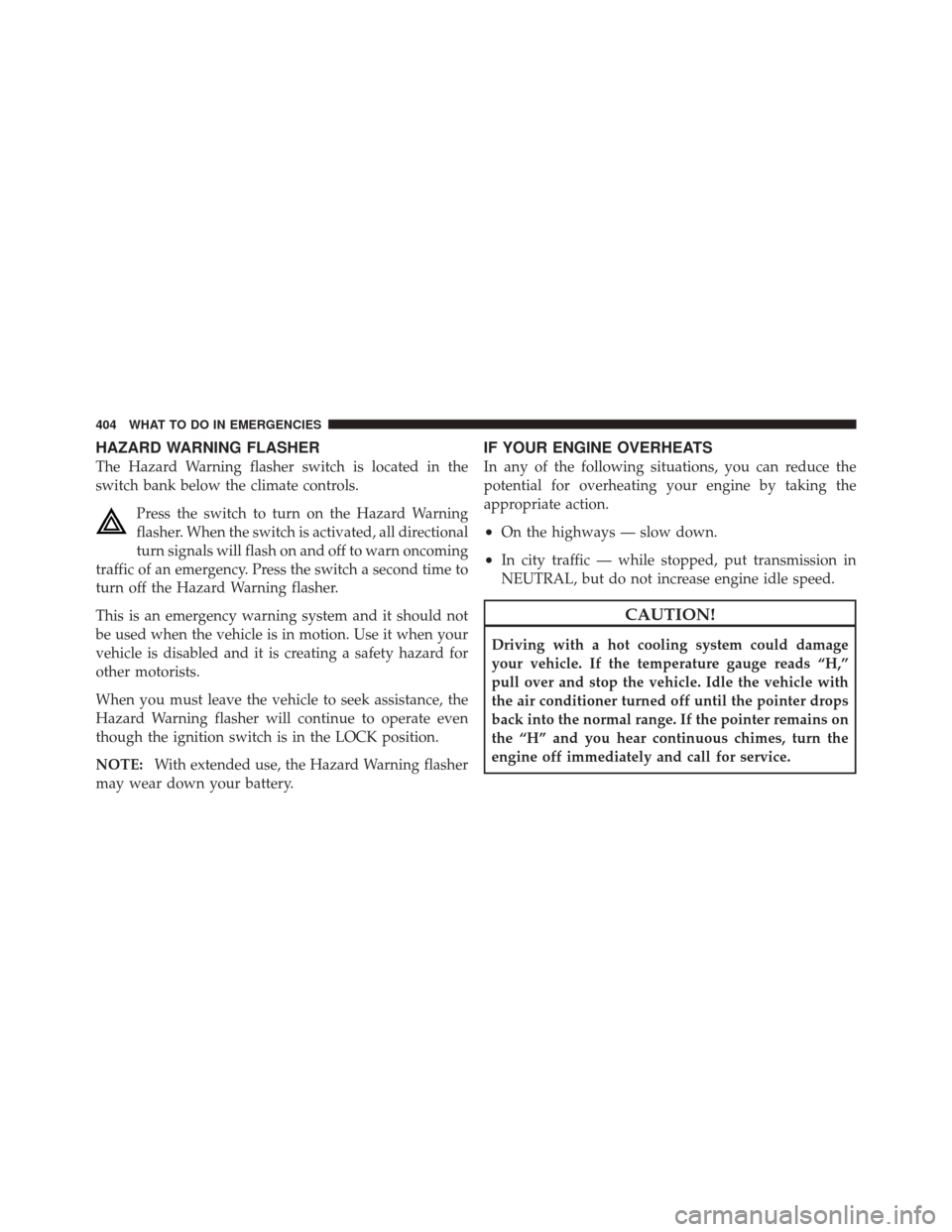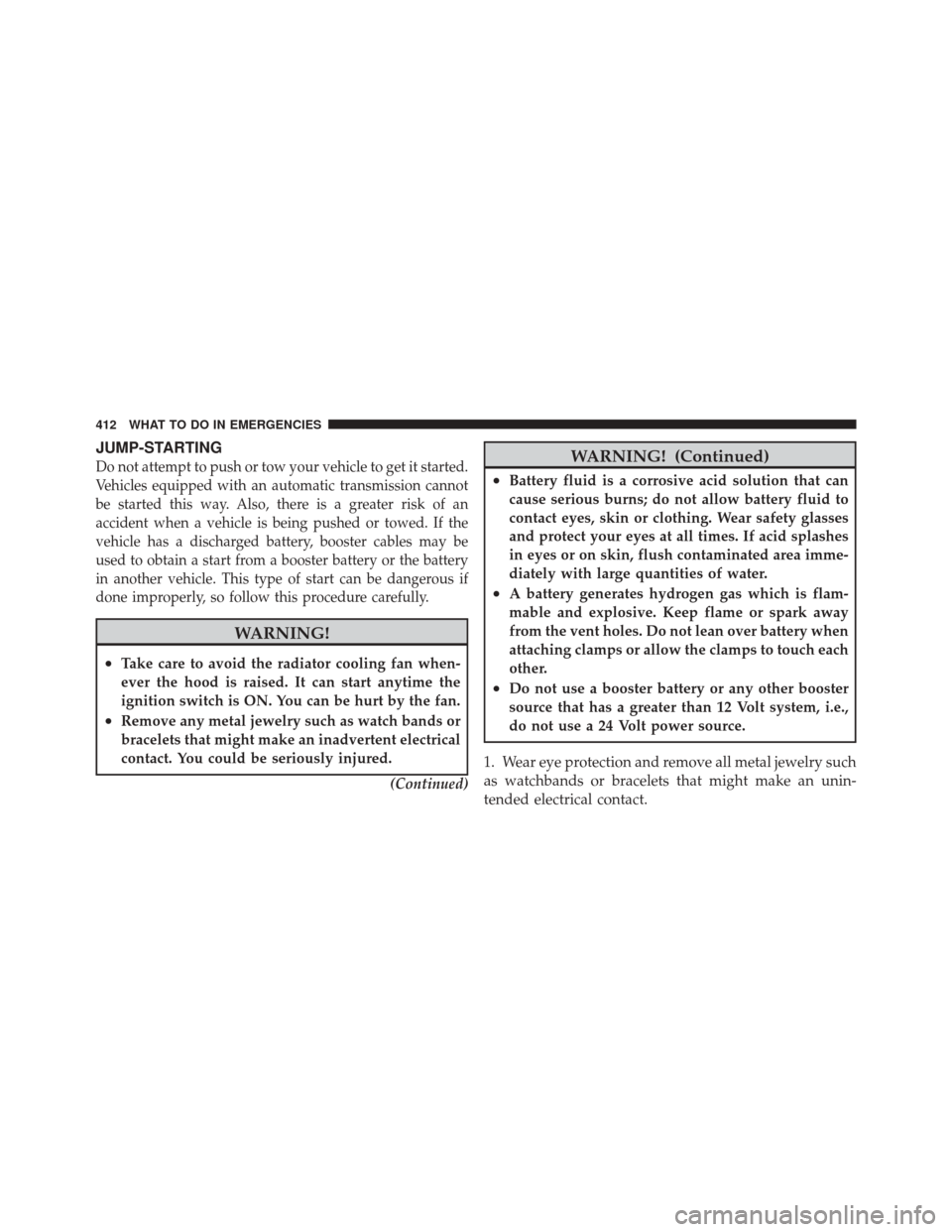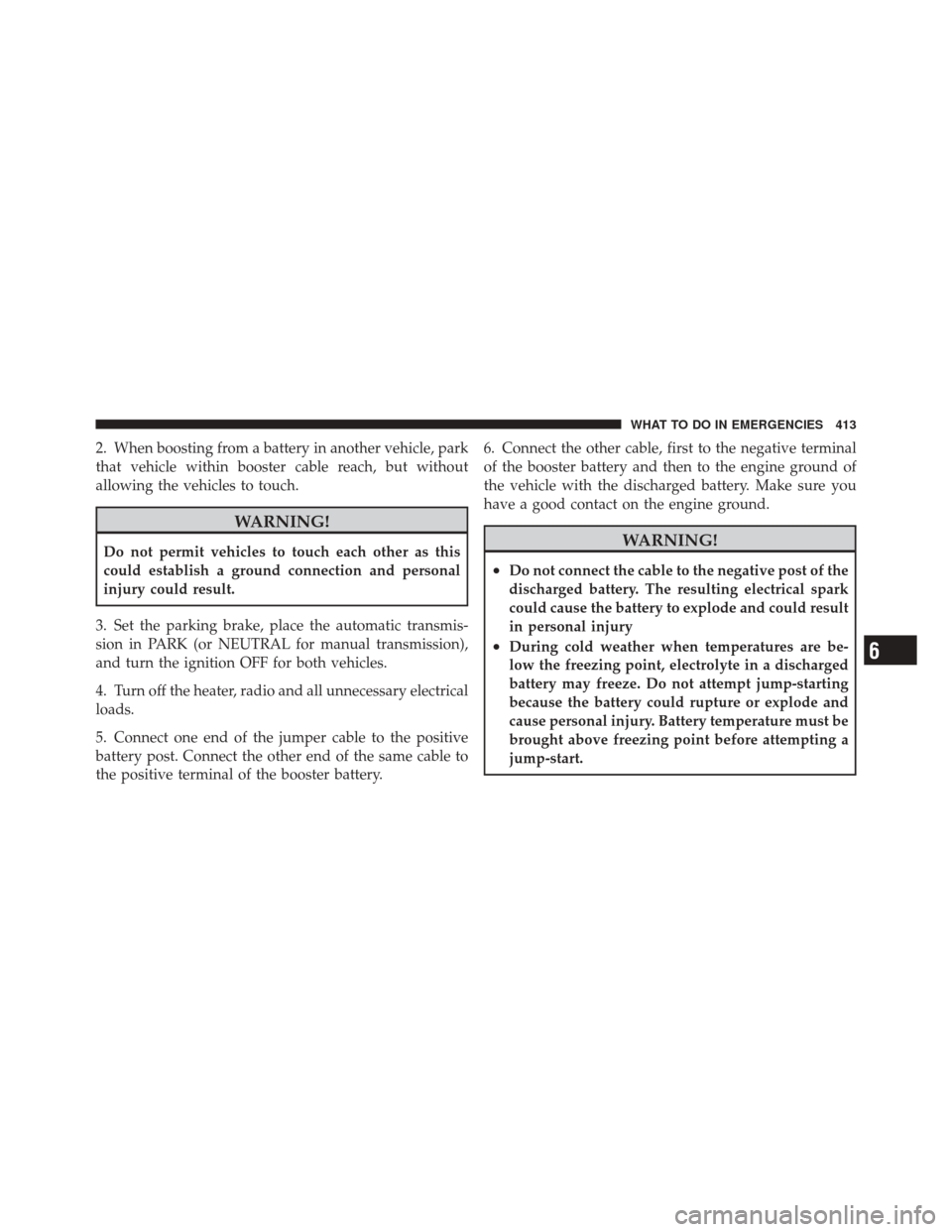Page 401 of 522

CAUTION!
Damage to the transmission may occur if the trans-
mission is shifted into PARK with the transfer case in
NEUTRAL and the engine RUNNING. With the
transfer case in NEUTRAL, ensure that the engine is
OFF prior to shifting the transmission into PARK.
Shifting Out of NEUTRAL
Perform the following procedure to prepare your vehicle
for normal usage:
1. Bring the vehicle to a complete stop.
2. Reconnect the negative battery cable.
3. Place the ignition switch in the LOCK position (if it
has been moved or the engine has been started).
4. Turn the ignition switch to the ON position, but do not
start the engine.5. Press the brake pedal.
6. Shift the transmission into NEUTRAL.
7. Use the point of a ballpoint pen or similar object to
press the recessed transfer case NEUTRAL button. Re-
lease the NEUTRAL button after the NEUTRAL indicator
light turns off (approximately one second). After the
NEUTRAL button is released, the transfer case will shift
to the position identified by the selector switch.
8. Start the engine.
9. Shift the transmission into DRIVE.
10. Set the parking brake.
11. Shift the transmission into PARK.
400 STARTING AND OPERATING
Page 405 of 522

HAZARD WARNING FLASHER
The Hazard Warning flasher switch is located in the
switch bank below the climate controls.Press the switch to turn on the Hazard Warning
flasher. When the switch is activated, all directional
turn signals will flash on and off to warn oncoming
traffic of an emergency. Press the switch a second time to
turn off the Hazard Warning flasher.
This is an emergency warning system and it should not
be used when the vehicle is in motion. Use it when your
vehicle is disabled and it is creating a safety hazard for
other motorists.
When you must leave the vehicle to seek assistance, the
Hazard Warning flasher will continue to operate even
though the ignition switch is in the LOCK position.
NOTE: With extended use, the Hazard Warning flasher
may wear down your battery.
IF YOUR ENGINE OVERHEATS
In any of the following situations, you can reduce the
potential for overheating your engine by taking the
appropriate action.
•On the highways — slow down.
•In city traffic — while stopped, put transmission in
NEUTRAL, but do not increase engine idle speed.
CAUTION!
Driving with a hot cooling system could damage
your vehicle. If the temperature gauge reads “H,”
pull over and stop the vehicle. Idle the vehicle with
the air conditioner turned off until the pointer drops
back into the normal range. If the pointer remains on
the “H” and you hear continuous chimes, turn the
engine off immediately and call for service.
404 WHAT TO DO IN EMERGENCIES
Page 408 of 522
CAUTION!
The winch mechanism is designed for use with the
jack extension tube only. Use of an air wrench or
other power tools is not recommended and they can
damage the winch.When the spare is clear, tilt the retainer at the end of the
cable, and pull it through the center of the wheel.
Preparations For Jacking
1. Park the vehicle on a firm level surface as far from the
edge of the roadway as possible. Avoid icy or slippery
areas.
WARNING!
Do not attempt to change a tire on the side of the
vehicle close to moving traffic. Pull far enough off
the road to avoid being hit when operating the jack
or changing the wheel.
2. Set the parking brake.
3. Place the shift lever into PARK (automatic transmis-
sion) or REVERSE (manual transmission).
4. Turn the ignition to the LOCK position.
Lowering/Raising Spare Tire6
WHAT TO DO IN EMERGENCIES 407
Page 409 of 522

5. Turn on the Hazard Warning flasher.6. Block both the front and rear of the
wheel diagonally opposite of the jack-
ing position. For example, if changing
the right front tire, block the left rear
wheel.
NOTE: Passengers should not remain in the vehicle
when the vehicle is being jacked.
Jacking Instructions
WARNING!
Carefully follow these tire changing warnings to
help prevent personal injury or damage to your
vehicle:
(Continued)
WARNING! (Continued)
•Always park on a firm, level surface as far from
the edge of the roadway as possible before raising
the vehicle.
•Block the wheel diagonally opposite the wheel to
be raised.
•Set the parking brake firmly and set an automatic
transmission in PARK; a manual transmission in
REVERSE.
•Never start or run the engine with the vehicle on a
jack.
•Do not let anyone sit in the vehicle when it is on a
jack.
•Do not get under the vehicle when it is on a jack.
•Only use the jack in the positions indicated and
for lifting this vehicle during a tire change.(Continued)
408 WHAT TO DO IN EMERGENCIES
Page 413 of 522

JUMP-STARTING
Do not attempt to push or tow your vehicle to get it started.
Vehicles equipped with an automatic transmission cannot
be started this way. Also, there is a greater risk of an
accident when a vehicle is being pushed or towed. If the
vehicle has a discharged battery, booster cables may be
used to obtain a start from a booster battery or the battery
in another vehicle. This type of start can be dangerous if
done improperly, so follow this procedure carefully.
WARNING!
•Take care to avoid the radiator cooling fan when-
ever the hood is raised. It can start anytime the
ignition switch is ON. You can be hurt by the fan.
•Remove any metal jewelry such as watch bands or
bracelets that might make an inadvertent electrical
contact. You could be seriously injured.(Continued)
WARNING! (Continued)
•Battery fluid is a corrosive acid solution that can
cause serious burns; do not allow battery fluid to
contact eyes, skin or clothing. Wear safety glasses
and protect your eyes at all times. If acid splashes
in eyes or on skin, flush contaminated area imme-
diately with large quantities of water.
•A battery generates hydrogen gas which is flam-
mable and explosive. Keep flame or spark away
from the vent holes. Do not lean over battery when
attaching clamps or allow the clamps to touch each
other.
•Do not use a booster battery or any other booster
source that has a greater than 12 Volt system, i.e.,
do not use a 24 Volt power source.
1. Wear eye protection and remove all metal jewelry such
as watchbands or bracelets that might make an unin-
tended electrical contact.
412 WHAT TO DO IN EMERGENCIES
Page 414 of 522

2. When boosting from a battery in another vehicle, park
that vehicle within booster cable reach, but without
allowing the vehicles to touch.
WARNING!
Do not permit vehicles to touch each other as this
could establish a ground connection and personal
injury could result.
3. Set the parking brake, place the automatic transmis-
sion in PARK (or NEUTRAL for manual transmission),
and turn the ignition OFF for both vehicles.
4. Turn off the heater, radio and all unnecessary electrical
loads.
5. Connect one end of the jumper cable to the positive
battery post. Connect the other end of the same cable to
the positive terminal of the booster battery. 6. Connect the other cable, first to the negative terminal
of the booster battery and then to the engine ground of
the vehicle with the discharged battery. Make sure you
have a good contact on the engine ground.WARNING!
•Do not connect the cable to the negative post of the
discharged battery. The resulting electrical spark
could cause the battery to explode and could result
in personal injury
•During cold weather when temperatures are be-
low the freezing point, electrolyte in a discharged
battery may freeze. Do not attempt jump-starting
because the battery could rupture or explode and
cause personal injury. Battery temperature must be
brought above freezing point before attempting a
jump-start.6
WHAT TO DO IN EMERGENCIES 413
Page 416 of 522
TOWING METHODS
NOTE: When towing a 4x4 model, the transfer case must be in NEUTRAL and the transmission must be in
PARK. Model Flat Towing (all four wheels ON theground) Flatbed Towing (all
four wheels sus-pended OFF the ground) Front Wheels
Raised, Rear Wheels on the Ground Rear Wheels Raised,
Front Wheels on the Ground
2 Wheel Drive Rear driveshaft must be removedRecommended
MethodSpeed less than
30 mph (48 km/h)
and distance less
than 15 miles
(24 km)Speed less than
30 mph (48 km/h)
and distance less
than 15 miles
(24 km)
4 Wheel Drive Transfer case must be in NEUTRAL and
transmission must be
in PARKRecommended
Method
NOT Permitted NOT Permitted
6
WHAT TO DO IN EMERGENCIES 415
Page 419 of 522
▫Cooling System ..................... 435
▫ Brake System ....................... 441
▫ Automatic Transmission ............... 443
▫ Transfer Case ....................... 444
▫ Front/Rear Axle Fluid ................. 445
▫ Sky Slider™Top Care ................. 446
▫ Appearance Care And Protection From
Corrosion .......................... 448
� Fuses .............................. 454
▫ Totally Integrated Power Module (TIPM) . . . 454
� Replacement Bulbs .................... 461 �
Bulb Replacement ..................... 461
▫ Headlamp ......................... 461
▫ Front Turn Signal And Front Side Marker
Lamp ............................. 462
▫ Front Fog Lamp ..................... 463
▫ Rear Tail/Stop, Turn Signal, And Back-Up
Lamp ............................. 464
� Fluid Capacities ...................... 465
� Fluids, Lubricants, And Genuine Parts ....... 466
▫ Engine ............................ 466
▫ Chassis ........................... 467
418 MAINTAINING YOUR VEHICLE